Icmp message type 3 codes Study guides, Class notes & Summaries
Looking for the best study guides, study notes and summaries about Icmp message type 3 codes? On this page you'll find 16 study documents about Icmp message type 3 codes.
Page 2 out of 16 results
Sort by
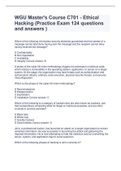
-
WGU Master's Course C701 - Ethical Hacking (Practice Exam 124 questions and answers
- Exam (elaborations) • 27 pages • 2022
- Available in package deal
-
- $13.49
- + learn more
Which of the following information security elements guarantees that the sender of a message cannot later deny having sent the message and the recipient cannot deny having received the message? A Confidentiality B Non-repudiation C Availability D Integrity Correct answer- B A phase of the cyber kill chain methodology triggers the adversary's malicious code, which utilizes a vulnerability in the operating system, application, or server on a target system. At this stage, the organizat...
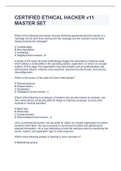
-
CERTIFIED ETHICAL HACKER v11 MASTER SET ALREADY GRADED A+
- Exam (elaborations) • 169 pages • 2022
-
- $12.98
- + learn more
Which of the following information security elements guarantees that the sender of a message cannot later deny having sent the message and the recipient cannot deny having received the message? A Confidentiality B Non-repudiation C Availability D IntegrityCorrect answer - B A phase of the cyber kill chain methodology triggers the adversary's malicious code, which utilizes a vulnerability in the operating system, application, or server on a target system. At this stage, the organization...
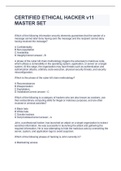
-
CERTIFIED ETHICAL HACKER v11 MASTER SET
- Exam (elaborations) • 169 pages • 2022
-
- $12.98
- + learn more
Which of the following information security elements guarantees that the sender of a message cannot later deny having sent the message and the recipient cannot deny having received the message? A Confidentiality B Non-repudiation C Availability D IntegrityCorrect answer - B A phase of the cyber kill chain methodology triggers the adversary's malicious code, which utilizes a vulnerability in the operating system, application, or server on a target system. At this stage, the organizat...
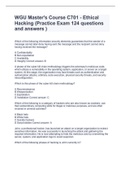
-
WGU Master's Course C701 - Ethical Hacking (Practice Exam 124 questions and answers )
- Exam (elaborations) • 27 pages • 2022
- Available in package deal
-
- $10.97
- + learn more
Which of the following information security elements guarantees that the sender of a message cannot later deny having sent the message and the recipient cannot deny having received the message? A Confidentiality B Non-repudiation C Availability D Integrity Correct answer- B A phase of the cyber kill chain methodology triggers the adversary's malicious code, which utilizes a vulnerability in the operating system, application, or server on a target system. At this stage, the organization...
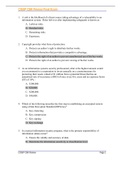
-
CISSP_ CBK _Review Final Exam
- Exam (elaborations) • 53 pages • 2021
-
- $17.49
- + learn more
CISSP CBK Review Final Exam CISSP CBK Review Page 1 1. A risk is the likelihood of a threat source taking advantage of a vulnerability to an information system. Risks left over after implementing safeguards is known as: A. Leftover risks. B. Residual risks. C. Remaining risks. D. Exposures. 2. Copyright provides what form of protection: A. Protects an author’s right to distribute his/her works. B. Protects information that provides a competitive advantage. C. Protects the right of an...
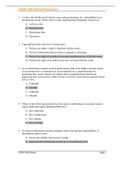
-
CISSP CBK Review Final Exam; Test bank (all answered correctly)
- Exam (elaborations) • 53 pages • 2021
-
- $10.49
- + learn more
CISSP CBK Review Final Exam CISSP CBK Review Page 1 1. A risk is the likelihood of a threat source taking advantage of a vulnerability to an information system. Risks left over after implementing safeguards is known as: A. Leftover risks. B. Residual risks. C. Remaining risks. D. Exposures. 2. Copyright provides what form of protection: A. Protects an author’s right to distribute his/her works. B. Protects information that provides a competitive advantage. C. Protects the right of a...

How much did you already spend on Stuvia? Imagine there are plenty more of you out there paying for study notes, but this time YOU are the seller. Ka-ching! Discover all about earning on Stuvia


